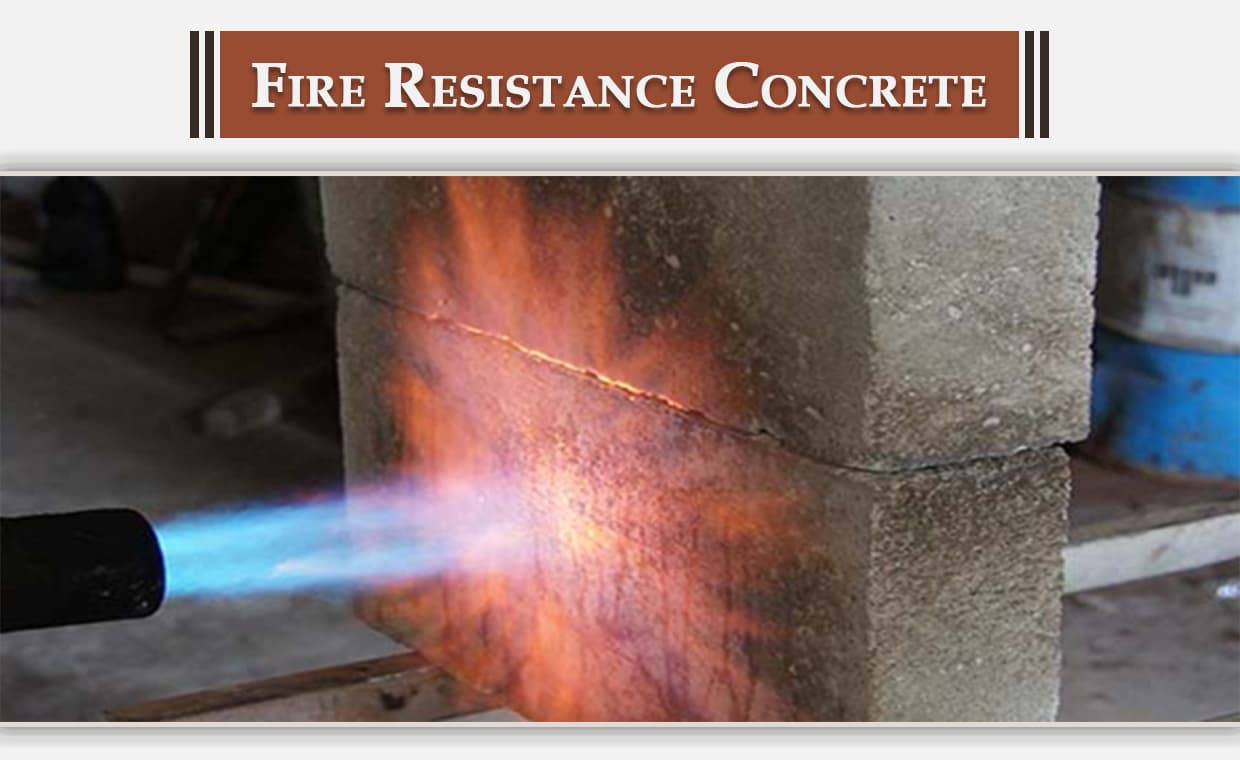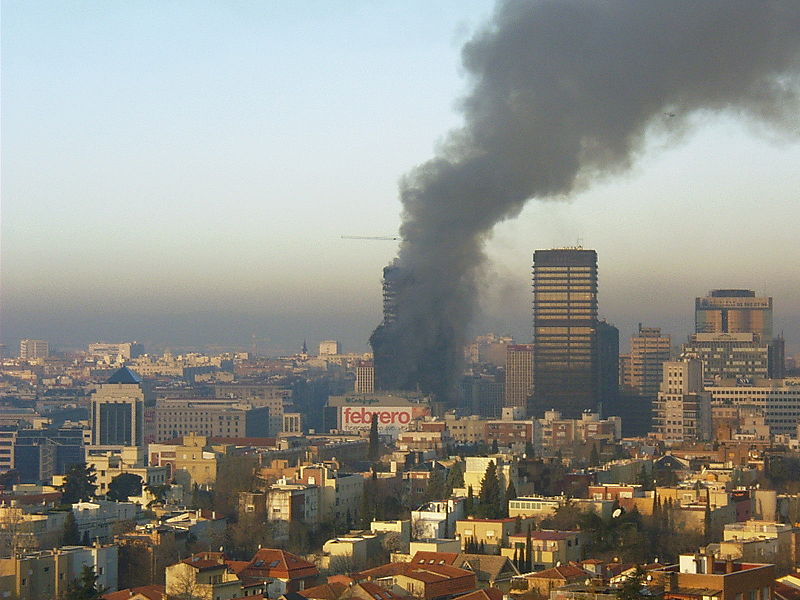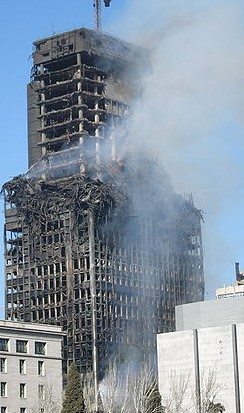
Concrete is an ideal building construction material being used in order to get the highest fire resistance of concrete structure and the best possible response in case of a fire in any structure. Concrete as a construction material, does not contribute to the fire load of Buildings. Without the use of any additional protective materials, it provides the essential fire protection, thermal insulation and serve as a barrier to fire spreading between compartments. In comparison to other building or construction materials, the use of concrete provides an easy, reliable and cost-effective fire resistive construction.

Fire resistance of concrete is considered one of the most important properties which protects life, property and the environment in the case of fire. It responds effectively to all the protective aims of safety and serviceability of building construction, benefiting everyone from building users, owners, businesses and residents to insurers, regulators and fire-fighters. Whether it is used for residential buildings, industrial warehouses or tunnels work, concrete can be designed and specified to remain robust even in the most extreme fire situations.
In case of any fire the following three things are very important:
01. Temperature of fire
02. Fuel of the fire
03. Duration of Fire
Compare to the other materials, fire resistance of concrete is very high and that is due to the following reasons:
- Concrete does not burn itself and hence does not contribute to fire load on the structure
- Due to the high fire resistance of concrete, spread of fire is prevented ab initio, unlike wood
- Concrete is a very good fire barrier, which ensures the easy escape routes with proper functional design
- Concrete does not melt, which otherwise would enhance spread of fire or invite collapse of building.
- Concrete does not produce smoke and toxic gases, thereby reducing the risk to personnel and fire-fighters during fire.
- Concrete holds the fire in, thereby reducing its spread to the surroundings
- Concrete acts as a fire protective material by itself; hence, under normal circumstances, no additional measures, materials, and expertise is required in the construction
- Concrete has an extremely high resilience to extreme temperatures, which makes it an ideal material for housing or storage areas that contain large fire loads.
- Concrete maintains integrity of the structure during the fire generation and extinction phases without the development of large deformations and overall movement of the structure or the individual spans, thereby facilitating the process of fire extinction without fear or worry of collapse.
- Due to the less thermal movements during the fire, it is ensured that the structure will not destabilize and/or collapse and also ensures that it will restrict spreading of fire due to loss of the barriers between the compartments.
- Concrete is not adversely affected by the water thrown on it during the fire
- Concrete can be easily repaired after the fire, thus saving both time and costs during rehabilitation works after fire, and hence structure can be readily put to use.
- Concrete used in tunnels as a paving material in contrast to asphalt which is a combustible and plastic material during a fire, ensures that the fire will not spread inside the tunnel. In addition, the fact that concrete retains its rigidity will makes it possible to intervene immediately during fire fighting to evacuate the personnel, without allowing for time for the pavement to cool.
- Concrete used in buildings in urban environments prevent the spread of fire to adjoining buildings.
Windsor Tower

Windsor Tower in Madrid

Windsor Tower in Madrid
The Windsor Tower in Madrid is a very good case of a modern high-rise building exposed to fire. The building had a burning concrete structure (slabs, shear wall cores, and interior columns) and perimeter columns of steel. It was destroyed by fire in 2005 which started on the 21st floor (out of 29 floors in total) and lasted 25 hours. The use of strong deep reinforced concrete Beam in the floors, as well as the remaining vertical load-bearing concrete elements (shear wall cores and columns), controlled the complete fall or collapse of the structure and gave an extremely long duration for resistance of the fire to the structure.
World Trade Centre
While the world trade centre tower which were hit by plances caused fire which resulted in burning of steel collapse, thus invited fast spread of fire resulting in total collapse of building. If perhaps, there would have been concrete column, it might have given some time to occupant to come out and save their life
Concrete Performance in Fire Resistive Construction
There are two key components of concrete, which are responsible for excellent performance in the fire:
- First its basic properties as a building material and
- Secondly, its functionality in a structure.
Concrete is non-combustible material (it does not burn) and it has a low rate of temperature increase across the section, which means that in all type of structures concrete can be used without any additional fire protection. Many types of concrete have consistent fire resisting properties no matter whether it is structurally normal or lightweight, or produced as concrete masonry or auto calved aerated concrete. Remember, no other material can make such a comprehensive case for its fire safety performance.
Effects of Temperature on the Properties of Concrete
Concrete properties that determine the response of a structural element in a fire depend on its composition, the type of aggregates, the initially contained moisture, and its age.
The density of the concrete material is only affected to a very small percentage and so is its thermal conductivity,
The specific heat of concrete material is affected, with an increase of up to 20% relative to the value at room temperature, when the temperature of the concrete mass (for limestone aggregates) reaches 1100 C.
The compressive strength of the concrete material is reduced when the temperature of the material exceeds 500° C.
During fire the concrete changes its colour with increase in temperature and it becomes from light brown to dark brown. So after the fire you can check the colour across the thickness and assess the temperature of the fire. Further after the certain temperature say 3000 to 5000 degree C, the concrete starts behaving as a refractory material itself and protect the subsequent inner layers of concrete from further effect of fire.
However, beyond this temperature it becomes brittle and does not remain elastic any more. In view of the same while repairing and retrofitting of any structure after fire, the first thing that needs to be checked is “whether the concrete behaves elastically or not?” Regular load tests should be performed and it should be checked whether the recovery of deflection is 80% or not?
Effect of Fire on Steel Reinforcement
As far as the steel reinforcement is concerned, its response depends on whether the steel is hot-rolled or cold-formed and is more sensitive than concrete at high temperature and because of this fact both the tensile yield strength and the modulus of elasticity is reduced already from 500ºC and 300ºC, respectively. For this situation, fire design regulations (such as the Indian code and all other Fire Safety Regulations) gives a minimum cover of the reinforcement in the design of an element for a definite period of fire resistance, in order to delay the increase in temperature of the steel by making use of the insulating property of the concrete cover.
All the National codes prescribes varying thickness of concrete cover to steel in reinforcement concrete elements. Structure designer decides the fire-resistant capacity of structure; say 1 hour or 4 hours and prescribe concrete cover to various structural elements. It is needless to say that the more the cover, the better the resistant to fire.
Also Read:
Pros and Cons of Steel Reinforcement Bars
8 Tips for You to Buy Steel Bars!
Concrete Does Not Burn Itself
Concrete does not burn itself, i.e. it does not act like a fuel in case of a fire. Concrete cannot be quickly set on fire like some other materials like wood in a building. It is resistant to mouldering materials, which can reach very high temperatures, igniting or even re-igniting. And flames due to burning also cannot ignite concrete. As it does not burn, itself, concrete does not emit any smoke, gases or toxic fumes when affected by a fire. It does not leave molten particles, which can cause ignition, unlike some plastics and metals. There is no case in which concrete can contribute to the breakout and spread of fire or add to the fire load.
Concrete is a Protective Material
Concrete has an excellent degree of fire resistance and, in the majority of applications, it can be specified as fireproof when properly designed. Concrete is very well in fire shielding. The mass of concrete contain a high heat storage capacity. Also, its porous structure formation provides a low rate of temperature rise throughout the section. These properties allow a low rate of temperature rise in concrete to act as an effective fire shield.
- Due to the low rate of increase in temperature through the cross-section of a concrete element, internal zones do not reach the same high temperatures as a surface exposed to flames.
- The standard fire test for concrete as per ISO 834, 160 mm wide x 300 mm deep concrete beams are exposed three sides to fire for one hour. Here temperature penetration reached 600°C which 16 mm from the surface. This shows clearly how concrete’s relatively low rate of increase in temperature ensures that its internal zones will remain well protected.
- Even after a prolonged period, the internal temperature of concrete remains relatively low; this enables to retain its structural capacity and fire shielding properties as a separating element.
Also Read:
What is a Precast Concrete?
In Which Type of Projects We can Use Precast Concrete?
Concrete Provides Effective Compartmentation
The majority of concrete structures are not destroyed in a fire, and so one of the major advantages of concrete is that it can usually be easily repaired afterward, thereby minimizing any inconvenience and cost. The modest floor loads and relatively low temperatures experienced in most building fires mean that the load-bearing capacity of concrete is largely retained both during and after a fire. For these reasons often all that is required is a simple clean up, Speed of repair and rehabilitation is an important factor in minimizing any loss of property after a serious fire.
Concrete is Easier to Repair After a Fire
Normally, depending on the type of aggregates used in concrete and the conventional exposure time to the fire, the design of a reinforced concrete structural member for fire involves the selection by the designer of the following:
The Member Dimensions, in Order To:
- Achieve the desired reduction of temperature from the exposed side of the element to the non-exposed side to about 140°C – in the case of slabs and walls, and
- Verify the load-bearing capacity of the element against the loads that are considered to act during the fire, after neglecting the cross-section area of the section where the concrete has crossed a given temperature (of the order of about 500°C), also in line with the simplified design method proposed in EN 1992-1-2.
- Provide proper distance between centre of the tensile reinforcement and the exposed surface, in order to limit the temperature in the reinforcement during the exposure time to the fire to a level below 500 – 550°C, at which point the yield strength of steel is reduced to service stress levels under the requirements of conventional load Regulations.
The Function of the Element:
- If it is a concrete column, the concurrent action of the axial load is taken into account (stability check under the axial load action during the fire).
- For beams and slabs, the prescribed design requirements are used with a relaxation of the relevant provisions towards the less restrictive side, in order to take into account the accepted favorable action of moment redistribution from the span to the supports during the fire, under the condition that this is possible to take place (continuity of the reinforcement, sufficient anchorage, monolithic construction).
- While using thick structural element with a relatively thick cover and additional surface over (skin) reinforcement individual rebars, wire mesh and the mix of polypropylene fibers; it will to avoid explosive spelling of the cover, a phenomenon that depends on the service moisture content in equilibrium with the atmosphere before the start of the fire and the compressive strength of the concrete (the requirements being more restrictive for high strength concrete).
Conclusion
The concrete performance in fire is much better as compared to other building materials, but the behavior of concrete in fire is not well characterized at present, and further research is on in almost every aspect of concrete behavior during the fire. The behavior of concrete mix materials to heating is fundamentally complex; for example, degradation in the physical properties of concrete varies strongly depending on the details of the concrete mix, the moisture content, and relevant atmospheric parameters, such as the maximum fire temperature and fire duration. Detailed studies on concrete structure performance in actual fire incidents can assist greatly in advancing knowledge of real-world behavior.
Must Read:
12 Tips to Prevent Fire at Our Home
10 Most Common Causes of Fire in Home
What is a Water Type of Fire Extinguisher?
Image Courtesy: Image 1, Image 2, Image 3
Author Bio
Bhushan Mahajan

































